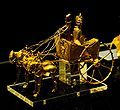- Oxus Treasure
-
The Oxus treasure is a collection of 170 gold and silver items from the Achaemenid Persian period which were found by the Oxus river.[1] Pieces from it are located in the Victoria and Albert Museum and in the British Museum (mainly the latter, where they have been on show from June 2007 in the newly re-displayed Room 52), with many items bequeathed to the nation by Augustus Wollaston Franks.[2]
Contents
Style
The griffin-headed bracelets from the hoard are typical of the 5th to 4th century BC court style of Achaemenid Persia. Bracelets of a similar form to ones from the treasure can be seen on reliefs from Persepolis being given as tribute, whilst Xenophon writes that armlets (among other things) were gifts of honour at the Persian court. Glass or semi-precious stone inlays within the bracelets' hollow spaces have now been lost.
History
A group of merchants acquired the Treasure (the precise findspot is unknown, but thought to be on the River Oxus); however, on the road from Kabul to Peshawar they were captured by bandits, who dispersed the Treasure before they were rescued by Capt. F.C. Burton, the British political officer in Afghanistan. He then helped them to recover the Treasure and, in gratitude, they sold him a companion piece to one of the bracelets now at the British Museum; this companion piece is now in the Victoria and Albert Museum. These merchants then continued to Rawalpindi to sell the rest of the Treasure. Thus pieces of the Oxus Treasure were then bought from the bazaars of India, and finally ended up in the British Museum after this long journey.
Items
References
- ^ The Achaemenians
- ^ edited by John Curtis and Nigel Tallis. "The British Museum 2005 ISBN 978-0-7141-1157-5". Forgotten Empire - The World of Ancient Persia.
Articles
- Stealing Zeus's thunder
- Tajik president calls for return of treasure from British Museum (Guardian - Tuesday April 10, 2007)
- "O. M. Dalton, The Treasure of the Oxus with Other Examples of Early Oriental Metal-Work", reviewed by Edwin M. Yamauchi - Journal of the American Oriental Society, Vol. 90, No. 2. (Apr. - Jun., 1970), pp. 340-343 (JSTOR - subscription required)
Pieces
(All links are British Museum unless otherwise noted.)
- Bracelet
- Gold head
- Gold jug
- Lion-griffin
- Gold plaque
- Gold scabbard
- Silver statuette
- Silver statuette
The British Museum Architecture Departments Africa, Oceania and the AmericasAkan Drum · Aubin Codex · Benin Bronzes · Briggs Enigma · Double-headed serpent · Hoa Hakananai'a · Throne of Weapons · Yaxchilan Lintel 24Ancient Egypt and SudanColossal head of Amenhotep III · Gebelein predynastic mummies · Hunters Palette · Rhind Mathematical Papyrus · Rosetta Stone · Sphinx of Taharqo · Younger MemnonAdmonitions Scroll · Bimaran casket · Kanishka casket · Mathura lion capital · Percival David Foundation of Chinese Art · Seated Buddha from Gandhara · The Great Wave off KanagawaGreece and RomeBassae Frieze · Elgin Marbles · Farnese Diadumenos · Harpy Tomb · Jennings Dog · Nereid Monument · Minoan Bull-leaper · Portland Vase · Warren CupMiddle EastBlack Obelisk of Shalmaneser III · Burney Relief · Cylinder of Nabonidus · Cyrus Cylinder · Flood tablet (Gilgamesh) · Library of AshurbanipalPrehistory and EuropeFranks Casket · Holy Thorn Reliquary · Hoxne Hoard · Lewis chessmen · Lindow Man · Mildenhall Treasure · Ringlemere Cup · Royal Gold Cup · Sutton Hoo · Swimming Reindeer · Vindolanda TabletsPrints and DrawingsDürer's Rhinoceros · Epifania · I Modi · Isabella Brant · The Ancient of Days · The Disasters of War · The Tale of the Flopsy Bunnies · Triumphal ArchOtherCoins and Medals · Conservation, Documentation and Science · Libraries and Archives · Portable Antiquities and Treasure · A History of the World in 100 ObjectsPeople Coordinates: 37°06′21″N 68°18′23″E / 37.10583°N 68.30639°E
Categories:- Middle Eastern objects in the British Museum
- Archaeology of the Achaemenid Empire
- Gold objects
- Silver objects
Wikimedia Foundation. 2010.











